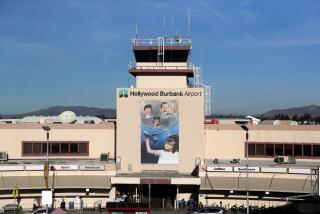Airport Panel Acts on Flights but Isn’t Sure What It Did
- Share via
The Burbank-Glendale-Pasadena Airport Authority has acted on the controversial question of allowing United Airlines to offer passenger flights from Burbank Airport, but members of the authority disagree over what they did.
The commissioner who offered the motion dealing with the United request said the panel postponed the issue for three weeks to await answers to safety and logistical questions raised by the size of United’s Boeing 767 jetliners, which are larger than passenger planes now using the airport.
But the president of the authority, Robert W. Garcin, insisted that the panel, in effect, approved United’s request to use the airport, and delayed approval only of the airline’s plan to fly 767s from the airport.
‘They’re on Board’
“They’re on board,” Garcin said of United.
The vote came at Monday’s meeting of the authority.
The announced plans by United to begin twice-daily flights between Burbank and Chicago on May 1 drew protests from associations representing homeowners in the East San Fernando Valley. They complained that increasing the number of airlines operating from the airport would increase jet noise.
Garcin said he told Airport Director Thomas E. Greer and United executives that they could proceed with plans to begin service May 1, as long as United does not use 767s without further approval of the authority.
But Commissioner Leland C. Ayers, who made the motion in question and voted for it, said it was meant to delay the entire question of service by United until the authority’s next meeting on Feb. 24.
Ayers said he had no intention of asking the airport authority to approve United’s request. The airline’s application mentioned only one kind of aircraft, he maintained, and postponing a decision on the acceptability of the airplane meant that a decision on the entire request was postponed.
Commission Gave OK
Garcin said, however, that the commission gave the only assent needed for United’s application through an action taken before the vote on Ayers’ motion. He said he was referring to their agreement by general consent--meaning no vote was taken--that the 767 meets the airport’s noise standards.
Airport executives have long contended that, under federal government and court rulings, the airport authority has no choice but to allow airlines whose planes meet the FAA’s Class III noise standards, the quietest category, to start service from the airport.
“The commissioners can think what they like,” Garcin said. “If the others didn’t understand the action we took, they’re free to phone me and I’ll chat with them.”
Ayers’ motion passed 7 to 1, with Burbank Mayor Mary Lou Howard voting against it, protesting that there was no vote on the basic issue of admitting United to the airport.
Another Burbank representative, Margie Gee, abstained to avoid a conflict of interest stemming from her association with lawsuits against the airport authority by anti-noise groups.
Motion’s Meaning Discussed
Howard and Gee also said they understood the motion to call for a delay in the decision.
The vote came after a lengthy discussion of what the motion meant and its effects. The motion was offered by Ayers and restated several times by Garcin.
Two other commissioners were uncertain later what the measure meant, although they said that did not concern them.
“I don’t think that issue was ever before us, whether they were accepted as a tenant,” Dr. Ellis Jones said. “I don’t want to interpret it.”
Said Carl Meseck: “It’s nothing we need to discuss. They’re not going to fly until May anyhow, and we’ll have all those problems resolved by then. In three weeks, we’ll have the answer, one way or another.”
Airport spokesman Victor Gill said: “It’s an ambiguous situation. They considered United’s application in a couple of phases. . . . No one disagreed that United met all the noise requirements.”
With the recent addition of TWA, eight airlines fly from Burbank.
Ayers said he wanted a report from the FAA on safety concerns dealing with the size of the 767, and from airport management on changes in airport layout needed to accommodate those jets.
The 767 has a wingspan of 156 feet, contrasted with 108 feet for the DC-9-80, the largest aircraft now carrying passengers from Burbank Airport. United’s wide-body 767 carries 197 passengers; the DC-9-80 carries 140 to 150.
Burbank Airport is under orders from the FAA to move its terminal, built in 1930, because parts of the building and aircraft at loading gates are too close to the runway to meet current safety standards.
Ayers has written to the FAA, asking for comments on use of the larger aircraft. If a DC-9-80 on the runway passed a similar plane boarding passengers at the terminal, the minimum distance between the planes’ wing tips would be 102 feet. In the same situation with two 767s, the distance would decrease about 24%, to 78 feet, he said.
Asked for Report
Ayers also asked for a report from airport management on the effect of plans to enlarge a passenger loading area to accommodate the larger planes by eliminating 50 spaces in the long-term parking lot.
A United spokesman said enlargement of the loading area will preserve the current distance between planes on the runway and aircraft loading passengers.
The even larger L-1011 flies in and out of the airport--from the neighboring Lockheed factory, not as a passenger carrier--without problems, he said.
More to Read
Sign up for Essential California
The most important California stories and recommendations in your inbox every morning.
You may occasionally receive promotional content from the Los Angeles Times.













